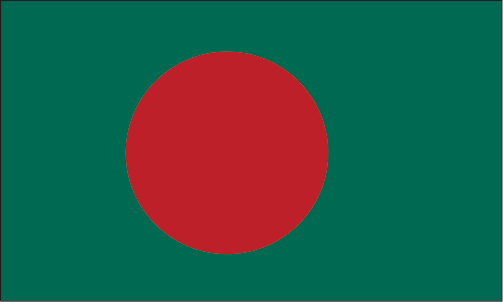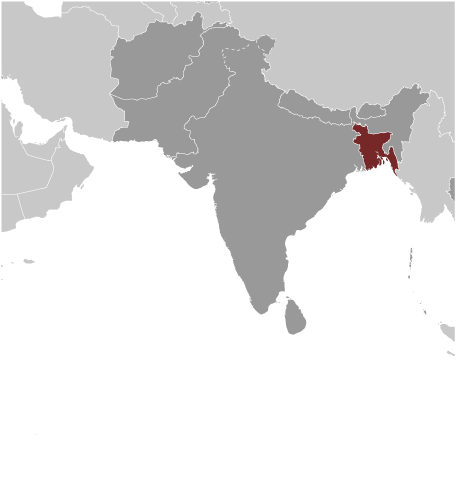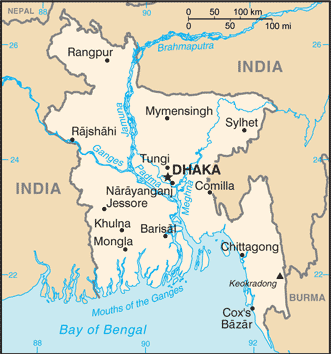|
Economy - overview:
|

|
|
In real terms Bangladesh's economy has grown 5.8% per year since 1996 despite political instability, poor infrastructure, corruption, insufficient power supplies, and slow implementation of economic reforms. Bangladesh remains a poor, overpopulated, and inefficiently-governed nation. Although more than half of GDP is generated through the service sector, 45% of Bangladeshis are employed in the agriculture sector with rice as the single-most-important product. Bangladesh's growth was resilient during the 2008-09 global financial crisis and recession. Garment exports, totaling $12.3 billion in FY09 and remittances from overseas Bangladeshis, totaling $11 billion in FY10, accounted for almost 12% of GDP.
|
|
|
GDP (purchasing power parity):
|

|
|
$305.5 billion (2012 est.)
country comparison to the world: 44
$288.1 billion (2011 est.)
$270.5 billion (2010 est.)
note:
data are in 2012 US dollars
|
|
|
GDP (official exchange rate):
|

|
|
$118.7 billion (2012 est.)
|
|
|
GDP - real growth rate:
|

|
|
6.1% (2012 est.)
country comparison to the world: 43
6.5% (2011 est.)
6.4% (2010 est.)
|
|
|
GDP - per capita (PPP):
|

|
|
$2,000 (2012 est.)
country comparison to the world: 192
$1,900 (2011 est.)
$1,800 (2010 est.)
note:
data are in 2012 US dollars
|
|
|
GDP - composition by sector:
|

|
|
agriculture: 17.3%
industry:
28.6%
services:
54.1% (2012 est.)
|
|
|
Labor force:
|

|
|
77 million
country comparison to the world: 7
note:
extensive export of labor to Saudi Arabia, Kuwait, UAE, Oman, Qatar, and Malaysia; workers' remittances were $10.9 billion in FY09/10 (2012 est.)
|
|
|
Labor force - by occupation:
|

|
|
agriculture: 45%
industry:
30%
services:
25% (2008)
|
|
|
Unemployment rate:
|

|
|
5% (2012 est.)
country comparison to the world: 46
5% (2011 est.)
note:
about 40% of the population is underemployed; many participants in the labor force work only a few hours a week, at low wages
|
|
|
Population below poverty line:
|

|
|
31.51% (2010 est.)
|
|
|
Household income or consumption by percentage share:
|

|
|
lowest 10%: 4%
highest 10%:
27% (2010 est.)
|
|
|
Distribution of family income - Gini index:
|

|
|
33.2 (2005)
country comparison to the world: 98
33.6 (1996)
|
|
|
Investment (gross fixed):
|

|
|
25.1% of GDP (2012 est.)
country comparison to the world: 51
|
|
|
Budget:
|

|
|
revenues: $13.98 billion
expenditures:
$19.62 billion (2012 est.)
|
|
|
Taxes and other revenues:
|

|
|
11.8% of GDP (2012 est.)
country comparison to the world: 204
|
|
|
Budget surplus (+) or deficit (-):
|

|
|
-4.8% of GDP (2012 est.)
country comparison to the world: 152
|
|
|
Public debt:
|

|
|
32% of GDP (2012 est.)
country comparison to the world: 109
33.9% of GDP (2011 est.)
|
|
|
Inflation rate (consumer prices):
|

|
|
8.8% (2012 est.)
country comparison to the world: 191
10.7% (2011 est.)
|
|
|
Central bank discount rate:
|

|
|
5% (31 December 2010 est.)
country comparison to the world: 72
5% (31 December 2009 est.)
|
|
|
Commercial bank prime lending rate:
|

|
|
13.3% (31 December 2012 est.)
country comparison to the world: 64
13.25% (31 December 2011 est.)
|
|
|
Stock of narrow money:
|

|
|
$14.1 billion (31 December 2012 est.)
country comparison to the world: 69
$13.19 billion (31 December 2011 est.)
|
|
|
Stock of broad money:
|

|
|
$66.84 billion (31 December 2011 est.)
country comparison to the world: 64
$66.14 billion (31 December 2010 est.)
|
|
|
Stock of domestic credit:
|

|
|
$80.81 billion (31 December 2012 est.)
country comparison to the world: 58
$68.57 billion (31 December 2011 est.)
|
|
|
Market value of publicly traded shares:
|

|
|
$23.55 billion (31 December 2011)
country comparison to the world: 66
$15.68 billion (31 December 2010)
$7.068 billion (31 December 2009)
|
|
|
Agriculture - products:
|

|
|
rice, jute, tea, wheat, sugarcane, potatoes, tobacco, pulses, oilseeds, spices, fruit; beef, milk, poultry
|
|
|
Industries:
|

|
|
jute, cotton, garments, paper, leather, fertilizer, iron and steel, cement, petroleum products, tobacco, drugs and pharmaceuticals, ceramic, tea, salt, sugar, edible oils, soap and detergent, fabricated metal products, electricity and natural gas
|
|
|
Industrial production growth rate:
|

|
|
7.4% (2011 est.)
country comparison to the world: 34
|
|
|
Current account balance:
|

|
|
-$941.9 million (2012 est.)
country comparison to the world: 109
$243.6 million (2011 est.)
|
|
|
Exports:
|

|
|
$25.79 billion (2012 est.)
country comparison to the world: 70
$24.56 billion (2011 est.)
|
|
|
Exports - commodities:
|

|
|
garments, knitwear, agricultural products, frozen food (fish and seafood), jute and jute goods, leather
|
|
|
Exports - partners:
|

|
|
US 19.4%, Germany 16.5%, UK 10%, France 7.3%, Italy 4.4%, Spain 4.2%, Netherlands 4.2% (2011)
|
|
|
Imports:
|

|
|
$35.06 billion (2012 est.)
country comparison to the world: 63
$32.58 billion (2011 est.)
|
|
|
Imports - commodities:
|

|
|
machinery and equipment, chemicals, iron and steel, textiles, foodstuffs, petroleum products, cement
|
|
|
Imports - partners:
|

|
|
China 18.2%, India 13.5%, Malaysia 4.9% (2011)
|
|
|
Reserves of foreign exchange and gold:
|

|
|
$10.19 billion (31 December 2012 est.)
country comparison to the world: 73
$9.192 billion (31 December 2011 est.)
|
|
|
Debt - external:
|

|
|
$36.21 billion (31 December 2012 est.)
country comparison to the world: 64
$33.84 billion (31 December 2011 est.)
|
|
|
Stock of direct foreign investment - at home:
|

|
|
$7.849 billion (31 December 2012 est.)
country comparison to the world: 85
$6.85 billion (31 December 2011 est.)
|
|
|
Stock of direct foreign investment - abroad:
|

|
|
$93.9 million (31 December 2012 est.)
country comparison to the world: 83
$92.9 million (31 December 2011 est.)
|
|
|
Exchange rates:
|

|
|
taka (BDT) per US dollar -
82.17 (2012 est.)
74.152 (2011 est.)
69.649 (2010 est.)
69.04 (2009)
68.554 (2008)
|
|
|
Fiscal year:
|

|
|
1 July - 30 June
|
|
|
|





 )
)



